Key Facts About Faith Ringgold
Renowned artist and black rights advocate Faith Ringgold passed away at the age of 93, leaving a significant legacy in the art world and social justice movements. Her powerful visual storytelling, which often tackled issues of race, representation, and equality, resonated with audiences worldwide.
Introduction of Early Life and Influences
- Ringgold was born in Harlem, New York City, in 1930, and grew up during the Harlem Renaissance, which greatly influenced her artistic sensibilities.
- She earned a Bachelor’s degree in Fine Arts and Education from the City College of New York in 1955 and later obtained a Master’s degree in Art from the same institution in 1959.
- Ringgold began her career as an art teacher in New York City public schools, a position she held for nearly two decades.
- In addition to her paintings and quilts, Ringgold authored and illustrated numerous children’s books, such as “Tar Beach” (1991) and “We Came to America” (1997), which celebrate African American culture and history.
- She was a professor of art at the University of California, San Diego, from 1987 until her retirement in 2002.
- Ringgold’s work has been exhibited in numerous prestigious institutions, including the Metropolitan Museum of Art, the Museum of Modern Art, and the Guggenheim Museum in New York City.
- In 1995, she was awarded the John Simon Guggenheim Memorial Foundation Fellowship for painting.
- Ringgold was inducted into the American Academy of Arts and Sciences in 2021.
- Her art has addressed various social and political issues, such as racism, gender inequality, and the HIV/AIDS crisis.
- Ringgold’s influence extends beyond the art world, as she has been recognized as a significant figure in the feminist and black power movements of the 1960s and 1970s.
Artistic Contributions of Faith Ringgold
Ringgold rose to fame through her innovative use of textiles and painting in her pictorial quilts. These quilts, which often depicted scenes from African American history and culture, were exhibited in prestigious venues such as the White House and museums around the world. In the 1960s, Ringgold created the “American People Series,” a collection of paintings that explored race relations in America during the civil rights movement. One of her most famous works, “American People Series #20: Die,” captures the turmoil of the era and remains a poignant representation of social unrest.
About her Social Activism
Inspired by the civil rights movement, Ringgold became a vocal advocate for black representation in the arts. In 1971, she founded the “Where We At” artists collective, which aimed to provide a platform for black women in the art world. Ringgold’s activism extended beyond her artwork, as she frequently protested against the underrepresentation of black and female artists in American museums.
Month: Current Affairs - April, 2024
Category: Awards, Honours & Persons in News








